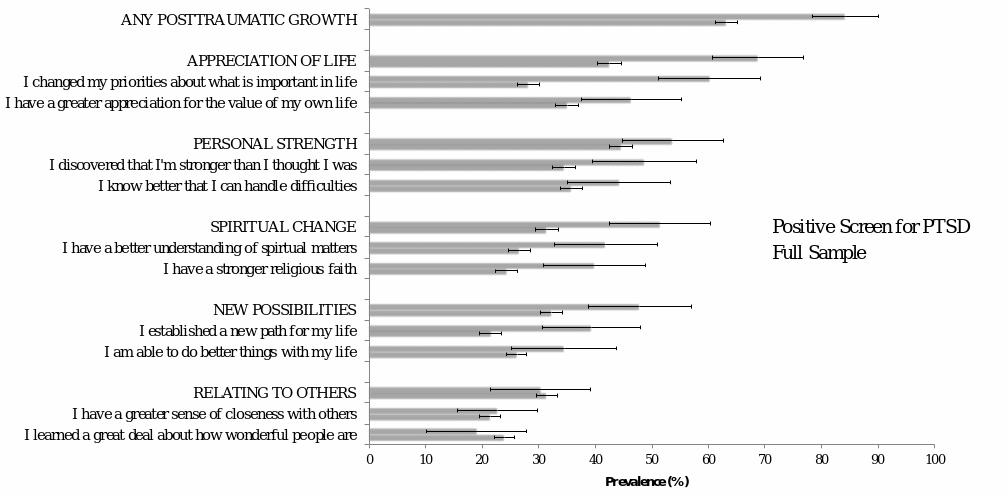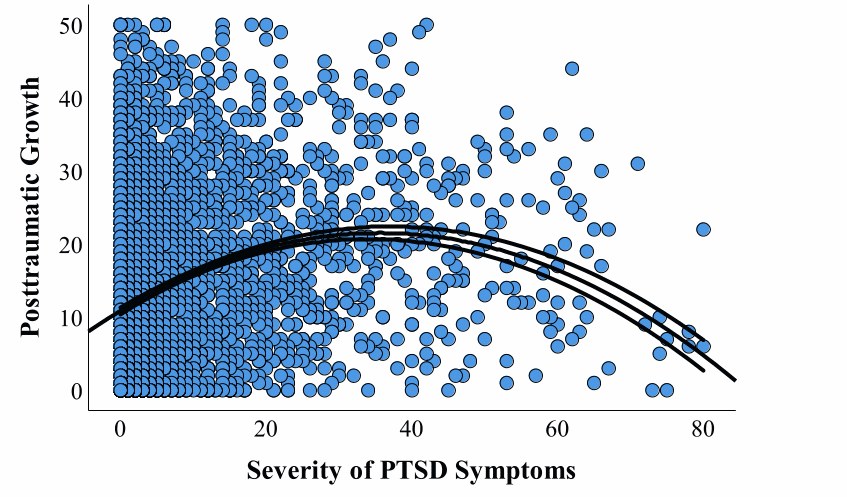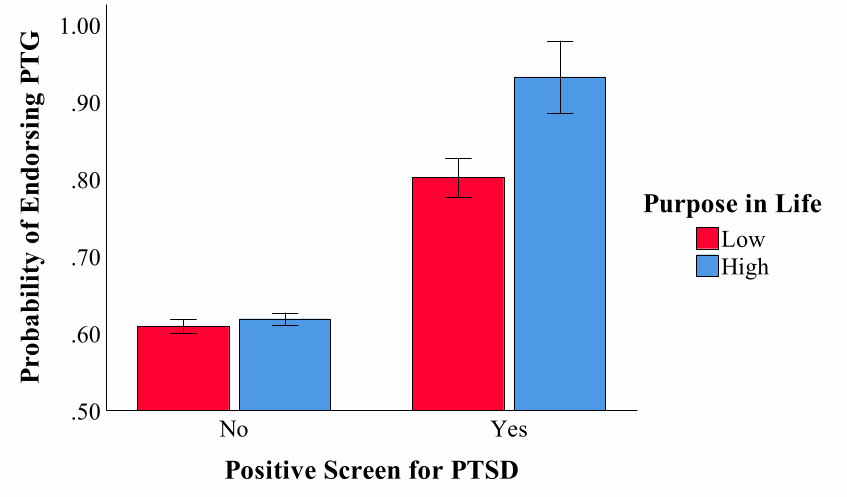Research Aims
Being in a distressing situation may lead to subsequent emotional suffering or regrowth. Exposure to potentially traumatic experiences (PTEs) may lead to the development of various mental disorders, most notably post-traumatic stress disorder (PTSD) (Tsai et al., 2016). Of particular concern are military veterans, as they are more likely than their civilian counterparts to be exposed to violent events such as combat (Tsai et al., 2015). In addition to adverse outcomes, exposure to PTEs has also been linked to post-traumatic growth (PTG), which consists of positive psychological development in areas such as a greater sense of personal strength, social connectedness, and religious/spiritual changes (Tedeschi et al., 2018). It has also been noted that veterans are especially prone to PTG achievement (Na et al., 2021). However, it is still unclear whether PTSD plays a pivotal role in PTG.
Previous literature has extensively focused on the prevalence of PTG in the military population. Several studies reported an overall PTG prevalence among veterans of 50-52%, suggesting an elevated level of PTG occurrence in veterans (Palmer et al., 2017; Pietrzak et al., 2021; Wu et al., 2019). It also means that PTG is a frequent phenomenon for veterans. However, concerning the five domains of PTG, other prevalence rates have been established. The most prevalent domains are proposed to be the appreciation of life and personal strength, which are most frequently reported by veterans who experienced PTG after trauma (Hijazi et al., 2015; Tsai et al., 2015). Some studies have also noted relating to others as a potentially prevalent PTG domain; nevertheless, appreciation of life and personal strength are more commonly referred to (Na et al., 2021). Individual resilience seems to play a critical in PTG among veterans.
The relationship between PTSD symptoms and PTG has also been a topic of interest for numerous researchers. As such, the nature of this association still remains a pertinent question. Mark et al. (2016) state the results of recent studies are mixed, suggesting the existence of a third variable, such as resilience, which may impact the connection. Schubert et al. (2016) corroborate this idea, proposing that the relationship between PTSD symptoms and PTG might be non-linear; however, the authors also note that very few articles appropriately measure PTSD diagnosis and PTG occurrence. Another interesting finding demonstrates that the veterans’ functioning is better when both PTSD symptoms and PTG are present (Tsai et al., 2016). In contrast, the likelihood of experiencing PTG and overall functioning tends to decrease in veterans who were not diagnosed with PTSD but had PTG.
Other aspects of PTG refer to the sociodemographic, trauma, health, and psychosocial factors that might promote PTG experiences in veterans. It has been proposed that such sociodemographic variables as age and ethnicity could be connected to PTG, with older veterans and those from ethnic minorities becoming more likely to develop PTG (Mark et al., 2016). Trauma severity also influences PTG, as moderately severe trauma more often results in successful PTG than non-severe or extremely intense negative experiences (Greenberg et al., 2021). Physical and mental health has also been linked to PTG occurrence, with some studies reporting that veterans who were more worried about their health could improve PTG prevalence (Na et al., 2021). Finally, some psychosocial aspects of PTG are deliberate rumination, social support, and resilience, which have been proposed to promote PTG experiences among veterans (Schubert et al., 2016). The combination of factors seems to play an essential role in PTG.
The first goal of this research is to describe the Prevalence of PTG – overall and in the five domains. The second goal is to describe the nature of the association between PTG and PTSD symptoms in veterans, determining whether its linear or non-linear. The third target is to define which sociodemographic, trauma, health, and psychosocial factors are related to PTG. The fourth aim is to identify if PTSD+PTG is associated with better functioning than PTSD-PTG. One additional area of interest could include evaluating whether PTSD and PTG comorbidity is connected to better functioning in comparison with PTSD symptoms presence only.
Although previous studies proposed that veterans with PTSD are more likely to experience PTG achievement, these works utilized the questionnaires based on the fourth edition of the Diagnostic and Statistical Manual for Mental Disorders (DSM-IV). Since slight differences in PTSD descriptions have been integrated, this project intends to refer to the most recent modification of the manual, DSM-V, released in 2013 (American Psychological Association [APA], 2013). It is possible that the novel 7-factor model could ideally account for the negative experiences connected to PTSD (Armour et al., 2015). Correlate analysis regressions, ROC curve analysis, and relative importance analysis will be the primary methods of analyzing the retrieved data. The study results are expected to be beneficial for promoting wellness and resilience among veterans, improving their capabilities for battling trauma, and maintaining a high quality of life.
Method
Participants
We analyzed data from the 2019-2020 National Health and Resilience in Veterans Study (NHRVS), which surveyed a nationally representative sample of 4,069 U.S. military veterans. In the current study, only those veterans who reported exposure to at least one potentially traumatic event on the Life Events Checklist for DSM-5 were included (n=3,764; 92.5% of the total sample). Veterans completed an anonymous, web-based survey. The NHRVS sample was drawn from KnowledgePanel®, a survey research panel of more than 50,000 households maintained by research firm Ipsos. KnowledgePanel® is a probability-based survey panel of a representative sample of U.S. adults that covers approximately 98% of U.S. households. Panel members are recruited through national random samples, originally by telephone and now almost entirely by postal mail. To permit generalizability of results to the entire U.S. veteran population, Ipsos computed post-stratification weights using the following benchmark distributions of U.S. veterans from the most recent (August 2019) Current Veteran Population Supplemental Survey of the Census Bureau’s American Community Survey: age, gender, race/ethnicity, metropolitan status, education, household income, a branch of service, and years in service. An iterative proportional fitting (raking) procedure was used to produce the final post-stratification weights. All study participants provided informed consent, and the research was approved by the Human Subjects Subcommittee of the V.A. Connecticut Healthcare System.
Measures
Table 1 describes variables that were examined as potential correlates of post-traumatic growth.
Post-traumatic Growth. Post-traumatic growth was assessed using the Posttraumatic Growth Inventory-Short Form (PTGI-SF; Cann et al., 2010; α=0.92). Total scores range from 0 to 50, and five subscales, including personal strength, relating to others, new possibilities, spiritual change, and appreciation of life, were assessed (sample item: “Please indicate the degree to which you experienced these changes in your life as a result of [WORST EVENT assessed on the LEC-5]: I know better that I can handle difficulties.”) Endorsement of “moderate,” “great,” or “very great” growth on any of the PTGI-SF items was indicative of PTG. Given that the distribution of PTGI-SF scores was zero-inflated, non-normal, and positively skewed (Kolmogorov-Smirnov test statistic=0.13, p<0.001), we dichotomized responses based on the moderate or greater endorsement of any item; this approach to operationalizing endorsement of PTG has been used in a meta-analysis on the prevalence of PTG (Wu et al., 2019), as well as a recent study on the prevalence of COVID-19 pandemic-related PTG (Pietrzak et al., 2021).
Mental Health Functioning. The Mental Health Component Summary score from the Medical Outcomes Study Short Form 8 Health Survey score (Ware et al., 2001) was administered to assess mental functioning. This score is comprised of items assessing role limitations caused by emotional problems, vitality, social functioning, and mental health. Higher scores better functioning.
Brief Inventory of Psychosocial Functioning (B-IPF). The Brief IPF is a 7-item self-report measure that assesses functional impairment over the past 30 days in romantic relationships, parenting, family relationships, friendship and socializing, work, education, and self-care. Twenty-three responses are on a 7-point Likert scale (0 = “Never”; 1-5 = “Sometimes”; 6 = “Always”; or “Not Applicable”). Scores on applicable items are summed, divided by the total possible score, and multiplied by 100 to yield a 0-100% range. Past research has shown strong psychometric properties; internal consistency in the current sample was α=0.85. Higher scores indicate greater psychosocial difficulties.
Data Analysis
Data analyses proceeded in four steps. First, we computed descriptive statistics to summarize study variables and compute the prevalence of PTG in each of the five domains assessed by the PTGI. Second, we fitted linear and quadratic functions between the severity of PTSD symptoms and PTGI-SF scores. An analysis of variance was implemented to determine which part provided the best fit to these data and explained the most variance in predicting PTGI-SF scores. Third, we conducted a multivariable logistic regression analysis to identify significant correlates of PTG; interactions between PTSD symptoms and protective variables such as personality and defensive psychosocial characteristics that were significantly associated with PTG were incorporated into this analysis to test for possible interactions among these variables. When multidimensional variables (e.g., PTSD symptoms, protective psychosocial characteristics) emerged as significant correlates of PTG, we conducted secondary analyses to evaluate which component aspects of these variables were independently associated with this outcome. Fourth, we conducted a multivariable analysis of variance (MANOVA) among veterans who screened positive for PTSD to examine whether endorsement of PTG in each of the five domains assessed by the PTGI-SF was associated with scores on measures of mental functioning and psychosocial difficulties.
Results
Prevalence of PTG
Figure 1 shows the prevalence of PTG in the entire sample and among veterans who screened positive for PTSD. In the whole sample, 63.2% endorsed PTG in one or more domains, with the most prevalent domains being personal strength (44.5%), appreciation of life (42.5%), and new possibilities (32.2%). Among veterans with a positive screen for PTSD, 84.2% endorsed PTG in one or more domains, with the most prevalent being appreciation of life (68.9%), personal strength (53.7%), and spiritual change (51.4%). Relative to veterans without a positive screen for PTSD, the prevalence of PTG was significantly higher among veterans with a positive screen for PTSD for endorsement of any PTG (84.1% vs. 61.6%; χ2(1)=52.31, p<0.001) and all PTG domains except relating to others (all χ2(1)>9.49, all p’s<0.003).
Association between PTSD symptoms and PTG
Results of a curve estimation analysis of the relationship between severity of PTSD symptoms and PTGI-SF scores revealed that a quadratic, inverted-U shaped function explained 60% more variance in these scores than a linear function (βquadratic= -0.43 vs. βlinear=0.22; t=11.00, p<0.001; R2quadratic=0.08 vs. R2linear=0.05). Figure 2 shows a scatterplot of the association between PCL-5 and PTGI-SF scores.
Sample Characteristics and Correlates of PTG
Table 2 shows descriptive statistics of the full sample and results of multivariable analysis of correlates of PTG. Significant correlations of PTG endorsement included non-White race/ethnicity, married/partnered status, lower household income, a greater number of adverse childhood experiences, direct and indirect traumas, the severity of PTSD symptoms, and higher scores on measures of agreeableness and conscientiousness, and protective psychosocial characteristics. When interaction terms were incorporated into this model, a significant interaction was observed between PTSD symptom severity and purpose in life (p=0.001; see Figure 3) and dispositional gratitude (p=0.007). Interactions between PTSD symptom severity and agreeableness and conscientiousness were insignificant (both p’s>0.05).
Secondary analyses revealed that, of the PTSD symptom clusters, greater severity of intrusive symptoms (OR=1.14, 95%CI=1.08-1.19; unwanted upsetting memories: OR=1.32, 95%CI=1.12-1.56; trauma-related emotional reactivity: OR=1.32, 95%CI=1.12-1.55), dysphoric arousal (OR=1.15, 95%CI=1.07-1.24; sleep difficulties: OR=1.22, 95%CI=1.11-1.34), and anxious arousal (OR=1.11, 95%CI=1.03-1.19; hypervigilance: OR=1.35, 95%CI=1.20-1.52) were independently associated with PTG. Further, of the protective psychosocial characteristics, higher scores on measures of dispositional gratitude (OR=1.08, 95%CI=1.01-1.15) and purpose in life (OR=1.04, 95%CI=1.02-1.06) were independently associated with this outcome.
Association between PTG and Functioning in Veterans with PTSD
Results of a MANOVA in veterans who screened positive for PTSD revealed that endorsement of improved social relationships (40.1±1.3 vs. 34.9±0.8; F=10.04, p=0.002; d=0.45, 95%CI=0.18-0.73) and personal strength (39.6±1.0 vs. 35.4±1.2; F=7.14, p=0.008; d=0.29, 95%CI=0.04-0.55) was associated with higher mental functioning scores, while endorsement of personal strength (34.4±2.1 vs. 43.8±2.6; F=7.37, p=0.007; d=0.39, 95%CI=0.14-0.65) and new possibilities (35.0±2.3 vs. 43.3±2.2; F=6.84, p=0.010; d=0.36, 95%CI=0.11-0.61) was associated with fewer psychosocial difficulties. None of the other associations were significant (all F’s<2.75, all p’s>0.09).
References
Armour, C., Tsai, J., Durham, T. A., Charak, R., Biehn, T. L., Elhai, J. D., & Pietrzak, R. H. (2015). Dimensional structure of DSM-5 post-traumatic stress symptoms: Support for a hybrid Anhedonia and Externalizing Behaviors model. Journal of Psychiatric Research, 61, 106–113.
APA. (2013). Diagnostic and statistical manual of mental disorders: DSM-5TM, 5th ed. American Psychiatric Publishing.
Bovin, M. J., Marx, B. P., Weathers, F. W., Gallagher, M. W., Rodriguez, P., Schnurr, P. P., & Keane, T. M. (2016). Psychometric properties of the PTSD checklist for diagnostic and statistical manual of mental disorders fifth edition (PCL-5) in veterans. Psychological Assessment, 28(11), 1379–1391.
Chen, I. H., Lin, C. Y., Zheng, X., & Griffiths, M. D. (2020). Assessing mental health for China’s police: psychometric features of the self-rating depression scale and symptom checklist 90-revised. International Journal of Environmental Research and Public Health, 17(8), 1-17.
Edemekong, P. F., Bomgaars, D. L., Sukumaran, S., & Levy, S. B. (2021). Activities of daily living. StatPearls Publishing.
Greenberg, J., Tsai, J., Southwick, S. M., & Pietrzak, R. H. (2021). Can military trauma promote psychological growth in combat veterans? Results from the national health and resilience in veterans study. Journal of Affective Disorders, 282, 732–739.
Hijazi, A. M., Keith, J. A., & O’Brien, C. (2015). Predictors of post-traumatic growth in a multi-war sample of U.S. combat veterans. Peace and Conflict: Journal of Peace Psychology, 21(3), 395–408.
Mark, K. M., Stevelink, S. A. M., Choi, J., & Fear, N. T. (2018). Post-traumatic growth in the military: A systematic review. Occupational and Environmental Medicine, 75(12), 904–915.
Na, P. J., Tsai, J., Southwick, S. M., & Pietrzak, R. H. (2021). Factors associated with post-traumatic growth in response to the COVID-19 pandemic: Results from a national sample of U.S. military veterans. Social Science & Medicine (1982), 289, 114409.
Palmer, E., Murphy, D., & Spencer-Harper, L. (2017). Experience of post-traumatic growth in U.K. veterans with PTSD: A qualitative study. Journal of the Royal Army Medical Corps, 163(3), 171–176.
Pietrzak, R. H., Tsai, J., & Southwick, S. M. (2021). Association of symptoms of post-traumatic stress disorder with post-traumatic psychological growth among U.S. veterans during the COVID-19 pandemic. JAMA Network Open, 4(4).
Tedeschi, R. G., Shakespeare-Finch, J., Taku, K., & Calhoun, L. G. (2018). Post-traumatic growth: Theory, research, and applications. Routledge.
Tsai, J., El-Gabalawy, R., Sledge, W. H., Southwick, S. M., & Pietrzak, R. H. (2015). Post-traumatic growth among veterans in the USA: Results from the national health and resilience in veterans study. Psychological Medicine, 45(1), 165–179.
Tsai, J., Sippel, L. M., Mota, N., Southwick, S. M., & Pietrzak, R. H. (2016). Longitudinal course of post-traumatic growth among U.S. military veterans: Results from the national health and resilience in veterans study. Depression and Anxiety, 33(1), 9–18.
Ware, J.E., Kosinski, M., Dewey, J.E., Grandek, B. (2001). How to score and interpret single-item health status measures: A manual for users of the SF-8 Health Survey. QualityMetric Incorporated.
Wu, X., Kaminga, A. C., Dai, W., Deng, J., Wang, Z., Pan, X., & Liu, A. (2019). The prevalence of moderate-to-high post-traumatic growth: A systematic review and meta-analysis. Journal of Affective Disorders, 243, 408–415.
Table 1. Variables examined as potential correlates of post-traumatic growth in U.S. military veterans
Table 2. Sample characteristics and results of multivariable regression models examining correlates of post-traumatic growth and functional difficulties in U.S. military veterans
Note. 95%CI=95% confidence interval; PTG=posttraumatic growth; PTSD=posttraumatic stress disorder.
Statistically significant association: *p<0.05; **p<0.01; ***p<0.001.

A positive screen for PTSD was operationalized as a PTSD Checklist for a DSM-5 score of 33 or higher.


Error bars represent 95% confidence intervals.